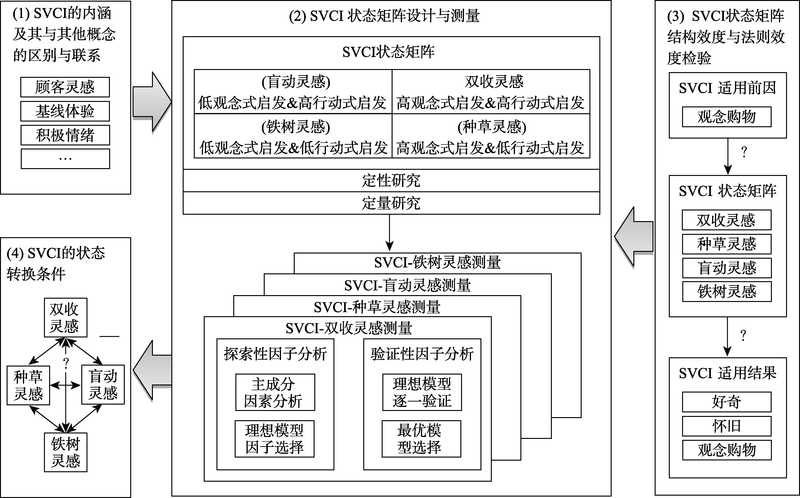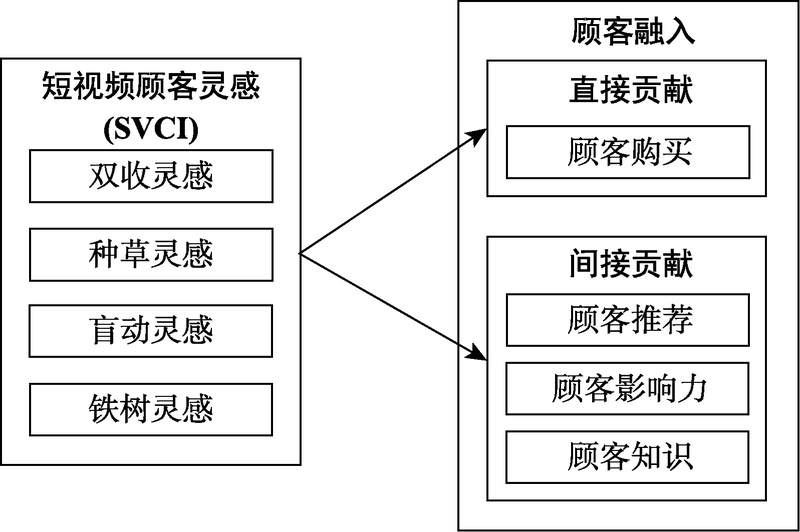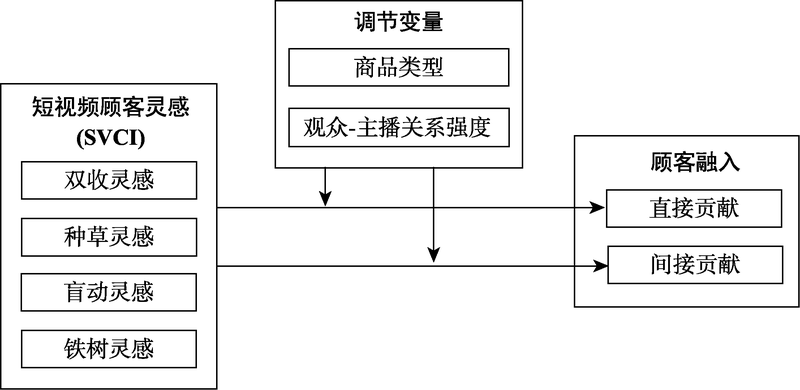 )
) 西北大学经济管理学院, 西安 710127
收稿日期:2019-10-14出版日期:2020-04-26发布日期:2020-03-27通讯作者:谢莹E-mail:xyy0556@126.com基金资助:* 国家自然科学基金项目(71972156, 71802158);陕西省社会科学基金项目(2018S42, 2017S022);陕西省教育厅专项科研计划项目(18JK0760, 18JK0748)The triggering mechanism of short video customer inspiration and its influence on customer engagement
GAO Peng, LI Chunqing, CHU Yujie, XIE Ying( )
) School of Economics and Management, Northwest University, Xi’an, 710027, China
Received:2019-10-14Online:2020-04-26Published:2020-03-27Contact:XIE Ying E-mail:xyy0556@126.com摘要/Abstract
摘要: 短视频顾客灵感(SVCI)是顾客灵感概念在短视频情境下的具象化, 是顾客由营销类短视频中获得的从接受营销引导的想法到转变为对消费相关目标的内在追求的激活状态。短视频顾客灵感的前因包括视频因素、主播因素和个人特质因素; 短视频顾客灵感中的观念式启发和行动式启发两个维度的交叉可以产生短视频顾客灵感状态矩阵, 矩阵中四种灵感状态在一定的条件下可以转化; 短视频顾客灵感通过直接贡献(顾客购买)和间接贡献(顾客推荐、顾客影响力和顾客知识)两条途径对顾客融入产生正向影响; 商品类型和消费者-主播关系强度在短视频顾客灵感对顾客融入的作用中起到调节作用; 短视频顾客灵感有助于揭示短视频营销中顾客灵感的触发机制及其对顾客融入的影响, 可以帮助消费类短视频主播和短视频平台产生更高效的营销内容和策略, 同时可以帮助消费者提升短视频购物的消费体验。
图/表 7
表1顾客融入定义的代表性观点
| 文献来源 | 发表年份 | 顾客融入的定义 |
|---|---|---|
| Higgins & Scholer | 2009 | 顾客与某一焦点客体互动过程中产生的一种被投入、占据、完全吸引的心理状态 |
| Bowden | 2009 | 使新顾客转换为忠诚顾客并持续购买的心理过程 |
| Van Doorn et al. | 2010 | 超越顾客购买关系的非交易行为, 包括口碑传播、撰写评论与博客、推荐、帮助其他顾客等行为 |
| Mollen & Wilson | 2010 | 客户基于其与品牌关系的认知与情感承诺而产生的行为 |
| Hollebeek | 2011 | 顾客在与品牌互动时进行认知、情感和行为投入的程度 |
| Brodie et al. | 2011 | 通过与焦点对象(如品牌)的互动和共同创造的顾客体验而产生的一种心理状态 |
| Vivek et al. | 2014 | 个体参与企业产品改进或其他活动的强度, 以及与产品或活动进行联结的强度 |
| Wirtz, Den Ambtman et al. | 2013 | 顾客因为对在线品牌社群的认同而产生的各种积极影响 |
| Hollebeek et al. | 2016 | 顾客对企业或品牌积极的、可效价化的表现与投入 |
| Pansari & Kumar | 2016 | 不止包含购买以外的行为(如顾客推荐、顾客影响和顾客知识), 也包括购买行为本身 |
| Pansari & Kumar | 2017 | 客户通过直接或间接贡献为企业增值的机制 |
| 陈静、于洪彦等 | 2017 | 融入主体在特定情境条件下, 通过与融入客体交易之外的互动体验所产生的, 体现出一定认知、情感与行为强度的与融入对象的联系强度 |
| 姚山季、王富家等 | 2018 | 用户自主开展的宣传、关注、或维护社区品牌与形象, 以及协助社区平台运营等的具体行为, 如口碑传播、推荐、反馈及评价等。 |
表1顾客融入定义的代表性观点
| 文献来源 | 发表年份 | 顾客融入的定义 |
|---|---|---|
| Higgins & Scholer | 2009 | 顾客与某一焦点客体互动过程中产生的一种被投入、占据、完全吸引的心理状态 |
| Bowden | 2009 | 使新顾客转换为忠诚顾客并持续购买的心理过程 |
| Van Doorn et al. | 2010 | 超越顾客购买关系的非交易行为, 包括口碑传播、撰写评论与博客、推荐、帮助其他顾客等行为 |
| Mollen & Wilson | 2010 | 客户基于其与品牌关系的认知与情感承诺而产生的行为 |
| Hollebeek | 2011 | 顾客在与品牌互动时进行认知、情感和行为投入的程度 |
| Brodie et al. | 2011 | 通过与焦点对象(如品牌)的互动和共同创造的顾客体验而产生的一种心理状态 |
| Vivek et al. | 2014 | 个体参与企业产品改进或其他活动的强度, 以及与产品或活动进行联结的强度 |
| Wirtz, Den Ambtman et al. | 2013 | 顾客因为对在线品牌社群的认同而产生的各种积极影响 |
| Hollebeek et al. | 2016 | 顾客对企业或品牌积极的、可效价化的表现与投入 |
| Pansari & Kumar | 2016 | 不止包含购买以外的行为(如顾客推荐、顾客影响和顾客知识), 也包括购买行为本身 |
| Pansari & Kumar | 2017 | 客户通过直接或间接贡献为企业增值的机制 |
| 陈静、于洪彦等 | 2017 | 融入主体在特定情境条件下, 通过与融入客体交易之外的互动体验所产生的, 体现出一定认知、情感与行为强度的与融入对象的联系强度 |
| 姚山季、王富家等 | 2018 | 用户自主开展的宣传、关注、或维护社区品牌与形象, 以及协助社区平台运营等的具体行为, 如口碑传播、推荐、反馈及评价等。 |

图1研究内容总体逻辑框架图
 图1研究内容总体逻辑框架图
图1研究内容总体逻辑框架图
图2研究1的主要内容框架
 图2研究1的主要内容框架
图2研究1的主要内容框架
图3研究2的主要内容框架
 图3研究2的主要内容框架
图3研究2的主要内容框架
图4SVCI状态矩阵
 图4SVCI状态矩阵
图4SVCI状态矩阵
图5研究3的主要内容框架
 图5研究3的主要内容框架
图5研究3的主要内容框架
图6研究4的主要内容框架
 图6研究4的主要内容框架
图6研究4的主要内容框架参考文献 56
| 1 | 陈静, 于洪彦, 刘容 . ( 2017). 服务型企业顾客融入驱动机制研究——基于体验的视角. 管理世界, ( 7), 184-185. |
| 2 | 陈可 . ( 2007). 商品类型对网上购物偏好性别差异的影响. 商场现代化, ( 5), 163-164. |
| 3 | 陈晓曦, 陈凤玲, 李斌, 刘耀中 . ( 2019). 好奇影响灵感产生的现象与机制:认知与情绪双加工路径. 心理科学进展, 27( 01), 1-10. |
| 4 | 何志华, 徐舟 . ( 2017). 短视频的制作创新. 新媒体研究, 3( 15), 123-124. |
| 5 | 黄京华, 金悦, 张晶 . ( 2016). 企业微博如何提升消费者忠诚度——基于社会认同理论的实证研究. 南开管理评论, 19( 04), 159-168. |
| 6 | 刘亚, 周长江, 杨哈韬 . ( 2012). 灵感的概念、结构与功能. 心理科学进展, 20( 11), 1834-1842. |
| 7 | 舒咏平 . ( 1997). 广义灵感论. 中国社会科学, ( 1), 63-76. |
| 8 | 杨颖, 朱毅 . ( 2016). 谁该成为体验型产品网络评论的主角, 图片还是文字? 心理学报, 48( 08), 1026-1036. |
| 9 | 张浩 . ( 2007). 略论灵感认识的特点. 唯实, ( 7), 4-7. |
| 10 | 张宏梅, 吴文秀 . ( 2019). 基于融入平台的顾客融入概念化及实证分析——以旅游移动平台为例. 旅游学刊, 34( 02), 37-47. |
| 11 | 赵丽娜, 韩冬梅 . ( 2015). 基于不同商品类型的在线评论感知有用性的实证. 统计与决策, ( 16), 108-111. |
| 12 | 朱翊敏, 于洪彦 . ( 2014). 顾客融入行为与共创价值研究述评. 管理评论, 26( 5), 111-119. |
| 13 | Arnold M. J., &Reynolds K. E . ( 2003). Hedonic shopping motivations. Journal of Retailing, 79( 2), 77-95. |
| 14 | Bolton R. N., &Drew J. H . ( 1991). A multistage model of customers' assessments of service quality and value. Journal of Consumer Research, 17( 4), 375-384. |
| 15 | B?ttger T., Rudolph T., Evanschitzky H., & Pfrang T . ( 2017). Customer inspiration: Conceptualization, scale development, and validation. Journal of Marketing, 86( 6), 116-131. |
| 16 | Brodie R. J., Hollebeek L. D., Juric B., & Ilic A . ( 2011). Customer engagement: Conceptual domain, fundamental propositions, and implications for research. Journal of Service Research, 14( 3), 252-271. |
| 17 | Cabiddu F., de Carlo M., & Piccoli G . ( 2014). Social media affordances: Enabling customer engagement. Annals of Tourism Research, 48, 175-192. |
| 18 | Chadborn D. &Reysen S. , ( 2018). Moved by the masses: A social identity perspective on inspiration. Current Psychology, 37( 3), 625-631. |
| 19 | Chatterjee P., Chollet B., & Trendel O . ( 2017). From conformity to reactance: Contingent role of network centrality in consumer-to-consumer influence. Journal of Business Research, 75, 86-94. |
| 20 | Evanschitzky H., Emrich O., Sangtani V., Ackfeldt A. L., Reynolds K. E., & Arnold M. J . ( 2014). Hedonic shopping motivations in collectivistic and individualistic consumer cultures. International Journal of Research in Marketing, 31( 3), 335-338. |
| 21 | Fernandes T. &Remelhe P. , ( 2016). How to engage customers in co-creation: Customers’ motivations for collaborative innovation. Journal of Strategic Marketing, 24( 3-4), 311-326. |
| 22 | Gilbert E. &Karahalios K. , ( 2014). Computing and building around tie strength in social media. Foundations and Trends in Human-Computer Interaction, 7( 3), 237-349. |
| 23 | Granovetter M.S . ( 1973). The strength of seak ties 1. American Journal of Sociology, 78( 6), 1360-1380. |
| 24 | Greve G .( 2014). The moderating effect of customer engagement on the brand image - brand loyalty relationship. Procedia - Social and Behavioral Sciences, 148, 203-210. |
| 25 | Harmonjones E., Harmonjones C., & Price T. F . ( 2013). What is approach motivation? Emotion Review, 5( 3), 291-295. |
| 26 | Hart, T. ( 1998). Inspiration: Exploring the experience and its meaning. Journal of Humanistic Psychology, 38( 3), 7-35. |
| 27 | Hollebeek L.D . ( 2011). Exploring customer brand engagement: Definition and themes. Journal of Strategic Marketing, 19( 7), 555-573. |
| 28 | Hollebeek L. D., Srivastava R. K., & Chen T . ( 2016). S-D logic-informed customer engagement: Integrative framework, revised fundamental propositions, and application to CRM. Journal of the Academy of Marketing Science, 47, 161-185. |
| 29 | Hong Y., Chen P. Y., & Hitt L. M . ( 2014). Measuring product type with dynamics of online review variances: A theoretical model and the empirical applications. Ssrn Electronic Journal. |
| 30 | Hsu C. L., Yu L. C., & Chang K. C . ( 2017). Exploring the effects of online customer reviews, regulatory focus, and product type on purchase intention: Perceived justice as a moderator. Computers in Human Behavior, 69, 335-346. |
| 31 | Jones S., Dodd A., & Gruber J . ( 2014). Development and validation of a new multidimensional measure of inspiration: Associations with risk for bipolar disorder. Plos One, 9( 3), e91669 |
| 32 | Kuehnl C., Jozic D., & Homburg C . ( 2019). Effective customer journey design: Consumers' conception, measurement, and consequences. Journal of the Academy of Marketing Science, 47( 3), 551-568. |
| 33 | Li X. , & Wu, L.( 2018). Herding and social media word-of-mouth:Evidence from groupon. Social Science Electronic Publishing, 42(4), 1331-1351. |
| 34 | Li X. &Zhang H. , ( 2017). The psychological mechanism of customer brand engagement behaviors: A self-determinant theory perspective. Tourism Tribune. 32( 7), 57-68. |
| 35 | Litman J.A . ( 2008). Interest and deprivation factors of epistemic curiosity. Personality & Individual Differences, 44( 7), 1585-1595. |
| 36 | Litman J. A., &Jimerson T. L . ( 2004). The measurement of curiosity as a feeling of deprivation. Journal of Personality Assessment, 82( 2), 147-157. |
| 37 | Litman J. A., &Pezzo M. V . ( 2007). Dimensionality of interpersonal curiosity. Personality & Individual Differences, 43( 6), 1448-1459. |
| 38 | Liu W., Sparks B., & Coghlan A . ( 2017). Fun, inspiration, and discovery: From momentary experiences to overall evaluations. International Journal of Contemporary Hospitality Management, 29( 7), IJCHM-12-2015-0735. |
| 39 | Lückmann P. ( 2015). Towards identifying success factors for cross-cultural project customer engagement: A literature review. Procedia Computer Science, 64, 324-333. |
| 40 | Mollen A. &Wilson H. , ( 2010). Engagement, telepresence and interactivity in online consumer experience: Reconciling scholastic and managerial perspectives. Journal of Business Research, 63( 9-10), 919-925. |
| 41 | Novak T. P., &Hoffman D. L . ( 2019). Relationship journeys in the internet of things: A new framework for understanding interactions between consumers and smart objects. Journal of the Academy of Marketing Science. 47( 3), 216-237 |
| 42 | Oleynick V. C., Thrash T. M., Lefew M. C., Moldovan E. G., & Kieffaber P. D . ( 2014). The scientific study of inspiration in the creative process: Challenges and opportunities. Frontiers in Human Neuroscience, 8, 436. |
| 43 | Oliver R. L., Rust R. T., & Varki S . ( 1997). Customer delight: Foundations, findings, and managerial insight. Journal of Retailing, 73( 3), 311-336. |
| 44 | Prentice C., Han X. Y., Hua L. L., & Hu L . ( 2019). The influence of identity-driven customer engagement on purchase intention. Journal of Retailing and Consumer Services, 47, 339-347. |
| 45 | Sawhney M., Verona G., & Prandelli E . ( 2010). Collaborating to create: The Internet as a platform for customer engagement in product innovation. Journal of Interactive Marketing, 19( 4), 4-17. |
| 46 | Schmeichel B. J., Cindy H. J., & Eddie H. J . ( 2010). Exercising self-control increases approach motivation. Journal of Personality & Social Psychology, 99( 1), 162-173. |
| 47 | Schouten J. W., Mcalexander J. H., & Koenig H. F . ( 2007). Transcendent customer experience and brand community. Journal of the Academy of Marketing Science, 35( 3), 357-368. |
| 48 | Stephan E., Sedikides C., Wildschut T., Cheung W. Y., Routledge C., & Arndt J . ( 2015). Nostalgia-evoked inspiration: Mediating mechanisms and motivational implications. Personality & Social Psychology Bulletin, 41( 10), 1395-1410. |
| 49 | Tajfel H. &Turner J. C . ( 1979). An integrative theory of intergroup conflict. Social Psychology of Intergroup Relations, 33, 94-109. |
| 50 | Thrash T. M., &Elliot A. J . ( 2003). Inspiration as a psychological construct. Journal of Personality & Social Psychology, 84( 4), 871-889. |
| 51 | Thrash T. M., &Elliot A. J . ( 2004). Inspiration: Core characteristics, component processes, antecedents, and function. Journal of Personality & Social Psychology, 87( 6), 957-973. |
| 52 | Thrash T. M., Maruskin L. A., Moldovan E. G., Oleynick V. C., & Belzak W. C . ( 2017). Writer-reader contagion of inspiration and related states: Conditional process analyses within a cross-classified writer x reader framework. Journal of Personality and Social Psychology, 113( 3), 466-491. |
| 53 | van de Ven N., Archer A. T. M., & Engelen B . ( 2019). More important and surprising actions of a moral exemplar trigger stronger admiration and inspiration. Journal of Social Psychology, 159( 4), 383-397. |
| 54 | van Doorn J., Lemon K. N., Mittal V., Nass S., Pick D., Pirner P., & Verhoef P. C . ( 2010). Customer engagement behavior: Theoretical foundations and research directions. Journal of Service Research, 13( 3), 253-266. |
| 55 | Verhoef P. C., Reinartz W. J., & Krafft M . ( 2010). Customer engagement as a new perspective in customer management. Journal of Service Research, 13( 3), 247-252. |
| 56 | Vivek S. D., Beatty S. E., Dalela V., & Morgan R. M . ( 2014). A generalized multidimensional scale for measuring customer engagement. Journal of Marketing Theory & Practice, 22( 4), 401-420. |
相关文章 15
| [1] | 张凯丽, 尹奎, 唐宁玉. 在什么情况下员工会汇报差错?基于秘密分享视角[J]. 心理科学进展, 2021, 29(7): 1149-1162. |
| [2] | 崔馨月, 李斌, 贺汝婉, 张淑颖, 雷励. 亲社会支出对主观幸福感的影响及其作用机制[J]. 心理科学进展, 2021, 29(7): 1279-1290. |
| [3] | 孙红月, 鲁盼, 蒋元萍. 跨期决策中的负折扣现象及其机制[J]. 心理科学进展, 2021, 29(7): 1291-1299. |
| [4] | 王泽军, 褚昕宇. 贝叶斯决策理论对复杂运动决策中运动预期的启发——以网球和足球为例[J]. 心理科学进展, 2021, 29(7): 1300-1312. |
| [5] | 李朋波, 陈黎梅, 褚福磊, 孙雨晴, 周莹. 我是高材生:资质过剩感及其对员工的影响[J]. 心理科学进展, 2021, 29(7): 1313-1330. |
| [6] | 孙国晓, 张力为. 竞赛压力、注意控制与运动表现关系的理论演进[J]. 心理科学进展, 2021, 29(6): 1122-1130. |
| [7] | 陈坤瑜, 王琦, 王霞, 邢采. 体验型消费和实物型消费的差异:研究方法及效应[J]. 心理科学进展, 2021, 29(6): 1111-1121. |
| [8] | 尹奎, 赵景, 李璨, 王宏蕾, 王崇锋. 领导授权行为的形成机制[J]. 心理科学进展, 2021, 29(6): 1097-1110. |
| [9] | 卢蕾安, 王春生, 任俊. 人们如何设想未来:未来情景思维对个体心理和行为的影响[J]. 心理科学进展, 2021, 29(6): 1086-1096. |
| [10] | 包寒吴霜, 蔡华俭. 姓名对个体心理与行为的实际影响:证据和理论[J]. 心理科学进展, 2021, 29(6): 1067-1085. |
| [11] | 彭坚, 曹兵兵. 追随者主动工作行为的上行影响:内隐追随视角[J]. 心理科学进展, 2021, 29(6): 967-977. |
| [12] | 王晓田, 王娜, 何金波. 前瞻性情绪作为社会风险的信息源假说:公共场景下风险决策的情绪及文化机制探讨[J]. 心理科学进展, 2021, 29(6): 959-966. |
| [13] | 黄元娜, 李云箫, 李纾. 为什么被选的和被拒的会是同一个备择选项?[J]. 心理科学进展, 2021, 29(6): 1010-1021. |
| [14] | 郝喜玲 刘依冉 杜晶晶 郑方. 失败恐惧的形成及对创业行为的影响[J]. 心理科学进展, 0, (): 0-0. |
| [15] | 林琳. 职场变革情境下的工作与工余塑造: 基于自我认同理论的双路径模型[J]. 心理科学进展, 2021, 29(5): 773-786. |
PDF全文下载地址:
http://journal.psych.ac.cn/xlkxjz/CN/article/downloadArticleFile.do?attachType=PDF&id=5034
